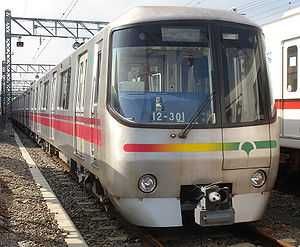Toei 12-000 series
| Toei 12-000 series | |
|---|---|
 12-300 series set, October 2006 | |
| In service | 1991–present |
| Manufacturer | Hitachi, Kawasaki Heavy Industries, Nippon Sharyo, Tokyu Car Corporation |
| Constructed |
1990–2001, 2011–present |
| Number in service | 440 vehicles (55 sets) |
| Number preserved | 2 vehicles |
| Formation | 8 cars per trainset |
| Capacity | 780 (328 seated) |
| Operator | Toei |
| Depot(s) | Kiba |
| Line(s) served | Toei Ōedo Line |
| Specifications | |
| Car body construction | Aluminium |
| Car length |
16,250 mm (end cars) 16,000 mm (intermediate cars) |
| Width | 2,490 mm |
| Height | 3,145 mm |
| Doors | 3 pairs per side |
| Maximum speed | 70 km/h (43 mph) |
| Traction system |
Linear motor (GTO-VVVF and IGBT-VVVF) |
| Power output | 1,920 kW |
| Acceleration | 3.0 km/h/s |
| Deceleration | 3.5 km/h/s (4.5 km/h/s for emergency brake) |
| Electric system(s) | 1,500 V DC |
| Current collection method | Overhead line |
| Bogies | FS545C |
| Braking system(s) | Regenerative brake, Brake-by-wire |
| Safety system(s) | ATC (ATO) |
| Track gauge | 1,435 mm (4 ft 8 1⁄2 in) |
The Toei 12-000 series (東京都交通局12-000形) is an electric multiple unit (EMU) train type operated by the Tokyo Metropolitan Bureau of Transportation (Toei) on the Toei Ōedo Line in Tokyo, Japan.
Formation
| Designation | M2c | M1 | M2 | M1 | M1 | M2 | M1 | M2c |
|---|---|---|---|---|---|---|---|---|
| Numbering | 12-xx1 | 12-xx2 | 12-xx3 | 12-xx4 | 12-xx5 | 12-xx6 | 12-xx7 | 12-xx8 |
Each M1 car is fitted with a lozenge-type pantograph.[1]
Interior
-

Interior view
-

Interior view, showing priority seating
-

Interior view of a 12-600 series car
12-600 series
Two new sets, classified 12-600 series, were delivered in fiscal 2011. Broadly based on the earlier 4th-batch design (sets 16 to 53), these sets included a number of design improvements.[2]
Formation
The 12-600 sets are formed as shown below.[2]
| Car No. | 1 | 2 | 3 | 4 | 5 | 6 | 7 | 8 |
|---|---|---|---|---|---|---|---|---|
| Designation | M2c | M1 | M2 | M1 | M1 | M2 | M1 | M2c |
| Numbering | 12-6x1 | 12-6x2 | 12-6x3 | 12-6x4 | 12-6x5 | 12-6x6 | 12-6x7 | 12-6x8 |
| Weight (t) | 25.5 | 25.9 | 25.8 | 25.9 | 25.9 | 25.8 | 25.9 | 25.7 |
| Capacity (total/seated) | 90/36 | 100/44 | 100/44 | 100/40 | 100/40 | 100/44 | 100/44 | 90/36 |
Interior
-

Interior of a 12-600 series set
-

A wheelchair space at the end of a car
-

Priority seating
History
Two prototype cars, numbered 12-001 and 12-002, were delivered from Tokyu Car Corporation in April 1986. These cars had stainless steel bodies and were originally built with conventional traction motors. The cars were converted to linear motor propulsion in 1987, with testing conducted on a special test track at Magome Depot. Following successful testing, it was announced in December 1988 that linear motor propulsion would be used for the new Toei Ōedo Line (then Line 12) under construction in Tokyo.
The first production trains were delivered as 6-car sets from Nippon Sharyo to Hikarigaoka Depot from September 1990 for testing on the line between Hikarigaoka and Nerima before entering revenue service in December 1991.[3]
A total of 424 vehicles were subsequently built by Nippon Sharyo and Hitachi up until 2001, formed as 53 8-car sets. The production trains featured aluminium bodies, and the first six sets were painted.[1][3]
The first 6th-batch 12-600 series set (cars 12-611 to 12-618) was delivered from the Kawasaki Heavy Industries factory in Hyōgo Prefecture in August 2011.[4] It entered service on 23 February 2012.[5]
-

Set 5 with painted aluminium body, November 2007
-

12-600 series set at Hikarigaoka Station, March 2012
Preserved examples

The two prototype cars, 12-001 and 12-002 are preserved at Chihaya Flower Park in Toshima, Tokyo.[6]
See also
References
- ↑ 1.0 1.1 私鉄車両編成表 2010 [Private Railway Rolling Stock Formations - 2010]. Japan: JRR. August 2010. p. 30. ISBN 978-4-330-15310-0.
- ↑ 2.0 2.1 "東京都交通局12-600形(大江戸線)" [Toei 12-600 series (Ōedo Line)]. Tetsudō Daiya Jōhō Magazine (Japan: Kōtsū Shimbun) 41 (336): p.82. April 2012.
- ↑ 3.0 3.1 Kajiwara, Hisashi (July 2009). "公営地下鉄在籍両数ビッグ3 東京都交通局" [Top 3 Subway Vehicle Owners: Toei]. Japan Railfan Magazine (Japan: Kōyūsha) 49 (579): p.128–139.
- ↑ "都営大江戸線向け12-600形が甲種輸送される" [Toei Oedo Line 12-600 series delivered]. Japan Railfan Magazine Online (in Japanese). Japan: Koyusha Co., Ltd. 29 August 2011. Retrieved 30 August 2011.
- ↑ "12-600形 営業運転開始" [12-600 series enters revenue service]. RM News (in Japanese). Japan: Neko Publishing. 24 February 2012. Retrieved 24 February 2012.
- ↑ Okada, Seiichi (September 2012). "魅惑の公園保存車両 4" [Fascinating park-preserved rolling stock (Part 4)]. Japan Railfan Magazine (Japan: Kōyūsha Co., Ltd.) 52 (617): p.96–97.
External links
| Wikimedia Commons has media related to Toei 12-000 series. |
- Nippon Sharyo 12-000 series information (Japanese)
| |||||||||||||||||